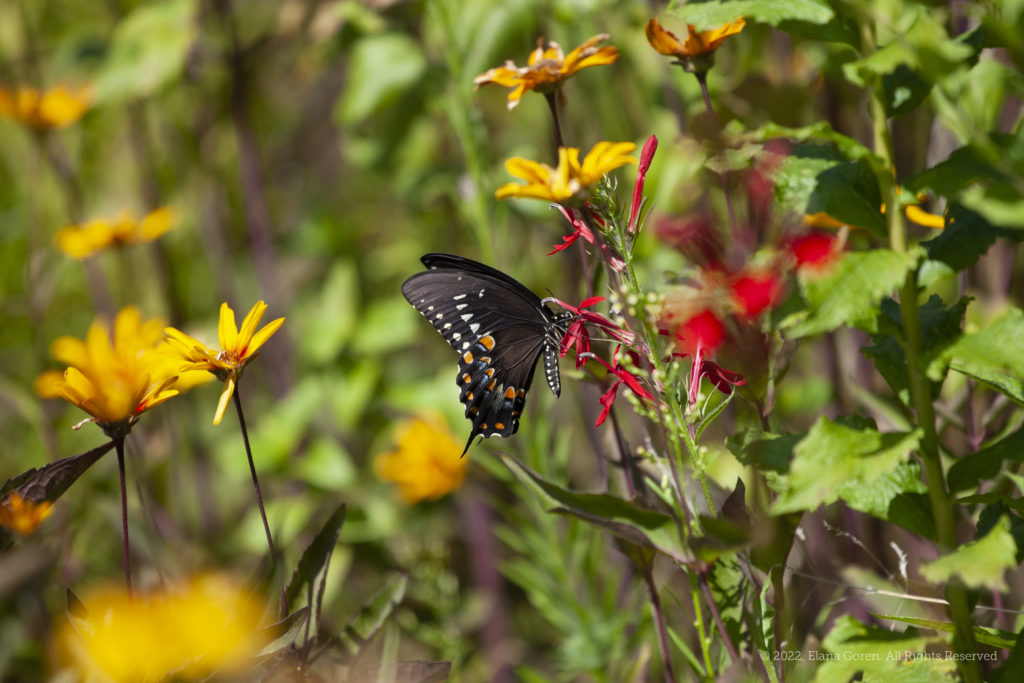
Photo taken on August 18 in zone 6b. ©2022, Elana Goren. All Rights Reserved.
This summer has been extremely brutal for plants. Here in the Northeast, long-established and mature trees are dropping their leaves and others’ leaves are just wilting and turning brown. We are in a severe drought here as are many places in the U.S.
But there are some plants that have risen and flourished where rain has been scarce for well over two months and the heat has topped temperature records for days in a row. I have Cardinal Flower, Lobelia cardinalis, shown in the photo above and it’s usually described as preferring moist soil, but I have found that it has done very well in the drought, on a slope and I haven’t watered it this summer. Other plants in the same area are Ox-Eye Sunflowers, Heliopsis helianthoides, which I planted as plugs last fall and they have done very well in the drought. I think that it may be because native plants are not only suited for their home environment but some are able to withstand and thrive under conditions in their native area that non-native plants may not be able to tolerate.
There are, however, times when it is crucial to water your plants, native or not, drought-tolerant or not. This is the case especially right after you plant something new, which is called watering-in, but is also crucial during the first growing season that your new plant is in the ground. And watering should be at ground level so that the water gets right to where it needs to be, at the roots. Overhead watering is discouraged for a few reasons: much of the water evaporates before it hits the ground, and not enough of the water gets to the roots; the plants’ leaves that get water on them are susceptible to diseases and pathogens that can also be spread from unhealthy plants to healthy ones with water spray. It’s better to have a soaker system set up to save time and water which puts the water exactly where it needs to be and is much less wasteful. You can also leave the hose on the ground next to the plant stem for a few minutes, but if you have a lot of plants, this can be time-consuming. The bigger the plant, the more water it will need with each watering. Every few days right after the new plants are in the ground, watering is recommended if it hasn’t rained. After a month or so, you can extend the time between waterings but make sure that your new plants are still getting the water that they need to develop. Check the soil and see how dry it is. Just don’t over-water. Even in a drought, be careful not to water too often which can lead to root-rot. Again, check the soil, if the soil is wet or moist, it doesn’t need any more water. If the plant is wilting and the soil is moist, the problem isn’t lack of water.
After the plants are established, usually after a year or two in the ground, they will be much better able to adapt to weather conditions like drought. This is when drought-tolerant plants really shine in the summertime. Healthy, mature plants will really start to show their colors, attract many different pollinators and always give this gardener a reason to smile.
What plants have done well in my garden during this dry year? Here’s a list which I will update with links for more info on these amazing native plants:
Beardtongue, Penstemon digitalis
Black-eyed Susan, Rudbeckia spp.
Cardinal Flower, Lobelia cardinalis
Coneflower, Echinacea purpurea
Eastern Bluestar, Amsonia tabernaemontana
Fleabane, Erigeron strigosus
Great Blue Lobelia, Lobelia siphilitica
Little Bluestem, Schizachyrium scoparium
Moss Phlox, Phlox subulata
Nodding Onion, Allium cernuum
Ox-Eye Sunflower, Heliopsis helianthoides
Obedient Plant, Physostegia virginiana
River Birch, Betula nigra
Showy Goldenrod, Solidago speciosa
Threadleaf Bluestar, Amsonia Hubrichii
Tickseed, Coreopsis verticillata
Wrinkle-Leaf Goldenrod, Solidago rugosa
